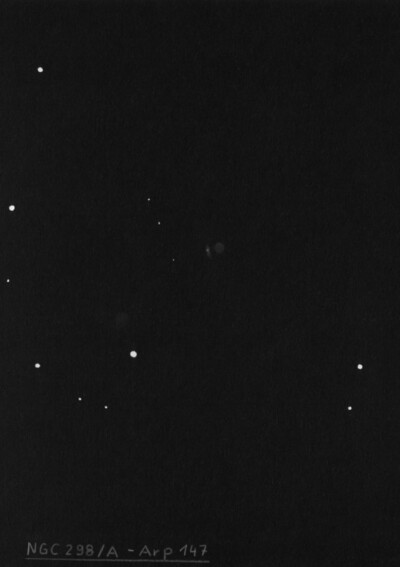
Stephane Javelle discovered IC 298 = J. 2-580 on 29 Dec 1893 and recorded "Small, nearly round, 1 'in diameter. It looks like the nebula covers two very small bright spots." Based on his description, it appears Javelle saw both components described in my observation. MCG appears to misidentify IC 298 as MCG +00-09-015 instead of MCG +00-09-014. Although IC 298 applies to both systems, PGC identifies the ring as IC 298 and the eastern component as IC 298A, while NED identifies the ring as IC 298A and the eastern system as IC 298B.
400/500mm - 18" (1/26/09): at 285x appeared very faint and small, elongated 2:1 ~N-S, ~18"x9", low even surface brightness. Located 3' NW of mag 9.3 SAO 111034. This is a remarkable pair of disrupted galaxies (Arp 147) forming a "10" or "IC" on images. The fainter western component (collisional Ring), forming the "C" or "0" was not visible.
900/1200mm - 48" (10/23/11): at 488x both components of this ring system were easily resolved. The eastern "collider" component (identified as IC 298A in PGC but IC 298B in NED) appeared moderately bright, fairly small, elongated 5:2 N-S, 24"x9", very small brighter core. The ring component (no nucleus) just west is a faint, small, irregularly round glow, ~20" diameter with a low but very uneven surface brightness. The rim was slightly brighter, creating a weak annular appearance, particularly on the east side. The system is located 3' NW of a mag 9.3 star.
Notes by Steve Gottlieb